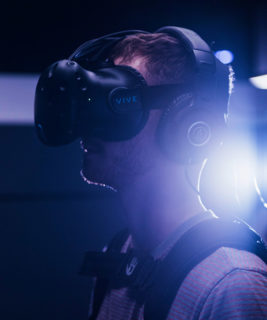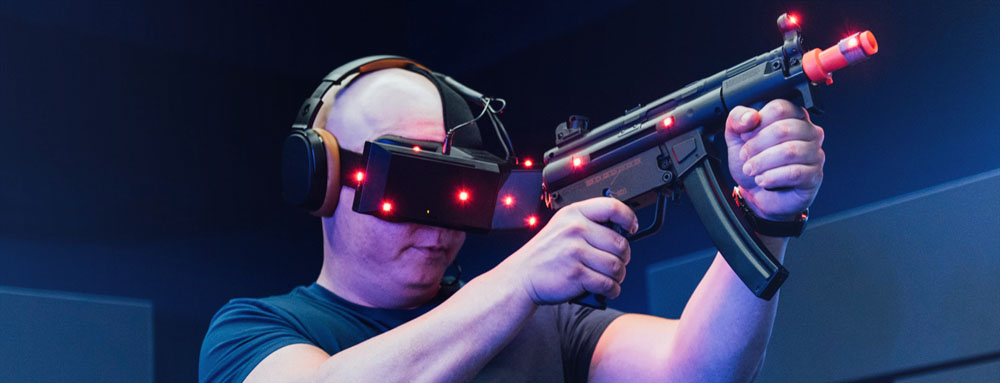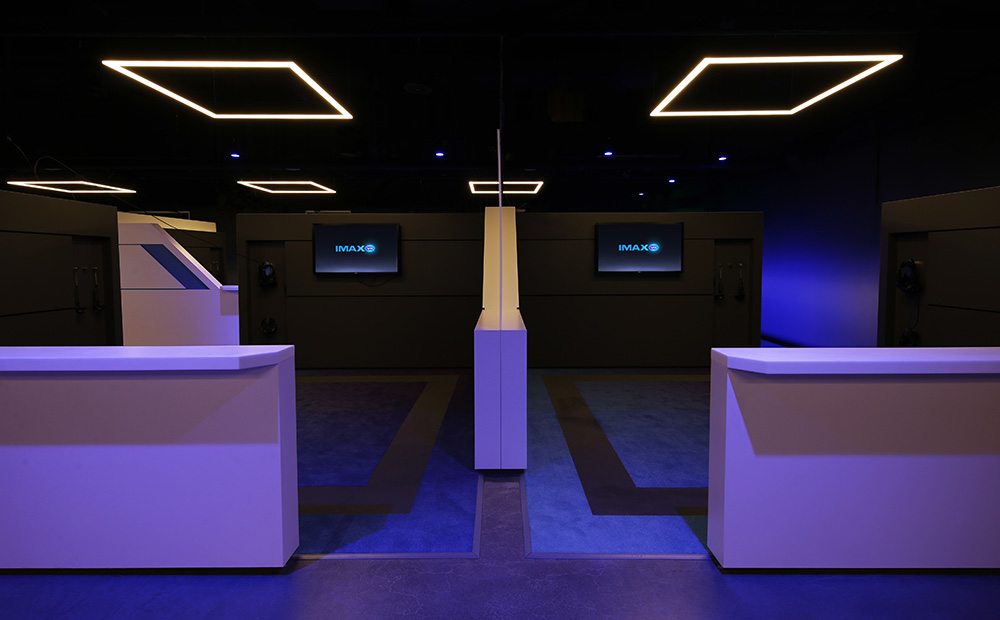After unveiling its flagship Los Angeles VR Centre in February, IMAX is bringing the experience across the country to New York City. The IMAX VR experience at AMC Kips Bay 15 soft launched on Memorial Day weekend and brought in over $2,000 in admissions by its second weekend, which is more than the LA location had taken in by its fifth weekend. Unlike the Centre in LA, which is a standalone complex, this one is located in the lobby of a Manhattan-based AMC multiplex theater, which is almost certain to attract moviegoers.
Thursday marked an official unveiling for the new location, which was attended by AMC CEO Adam Aron and IMAX CEO Richard Gelfond, who discussed their partnership and the future of these VR arcades.
“We are terrifically excited about the potential of virtual reality as an experience to make a movie theater a better place to visit,” said Aron during the opening remarks. “As consumers—especially younger consumers—see what we have to offer, we think they’re going to be very excited.”
The AMC Kips Bay 15 is the first of many theaters across the US to feature an IMAX VR Centre. Although IMAX will not be working exclusively with AMC, Gelfond said that AMC remains IMAX’s biggest partner in the world and the two companies have a very close partnership. Gelfond expanded on the point by saying that both companies see things the same way.
“[With millennials], we need to keep evolving the experience in order to create something that they want to come back to—something that will bring them into the multiplex, and this is one example of that,” said Gelfond. “We’re very proud to be partnering with AMC on it.” In the same way IMAX offers a movie experience that gets people off the couch to see, IMAX is using VR is a means to bring more millenials to movie theaters.
 The New York IMAX VR Centre is comprised of several 11-foot rooms (referred to as pods) that can be divided into smaller parts for multiplayer events. Experiences include video games such as Eagle Flight and the frenetic shooter Raw Data, while Raising a Ruckus is more of an animated VR movie that is enhanced by seats that tilt and rumble in sync with the experience.
The New York IMAX VR Centre is comprised of several 11-foot rooms (referred to as pods) that can be divided into smaller parts for multiplayer events. Experiences include video games such as Eagle Flight and the frenetic shooter Raw Data, while Raising a Ruckus is more of an animated VR movie that is enhanced by seats that tilt and rumble in sync with the experience.
Movie tie-ins include The Walk, where users can tightrope walk between the Twin Towers, and The Mummy: Prodigium Strike, developed by Starbreeze (John Wick Chronicles). Prodigium Strike, which is presented using Starbreeze’s own StarVR platform (others were on the HTC Vive), is a shooting game where players are equipped with a plastic VR rifle and are challenged to repel the zombie horde. The experience debuts alongside the movie and it complements the free pop-up Zero Gravity Stunt VR Experience that was shown at Rockefeller Center.
AListDaily sat down with Rob Lister, chief business development officer at IMAX, at the showcase event to talk about how the company was working to grow its VR Centres.

How would you describe the IMAX VR experience?
IMAX VR is an immersive new platform on which to experience the most interactive content available for virtual reality.
What led to choosing the AMC Loews Kips Bay 15 for its New York debut?
We have a standalone location in Los Angeles, which we own and operate, but our model is based upon working with our multiplex partners around the world to install VR Centres in lobbies or auditoriums. This is our first opportunity to pilot that model and see how it works when we inhabit a space within a multiplex and we look to attract not only multiplex audiences, but incremental bodies into our Centres. Particularly, millennials and Generation Z.
What is the long-term goal for location-based VR experiences like this one?
Location-based Centres need to offer premium experiences that you can’t get in your home. Even when the home experience becomes more ubiquitous, location-based experiences need to offer something that’s really compelling. In the same way an IMAX movie gets you off your couch and into a multiplex, an IMAX VR Centre needs to be different and better, with premium content that’s highly interactive.
How do you select some of the experiences that are featured at the IMAX VR Centres?
I’d say the first criterion is probably interactivity. People are paying for this experience, so you don’t want it to just be a trailer for a movie. You want people to feel truly immersed and have them interacting with their environment rather than passively watching a 360-degree video.
How often will these experiences be rotated out for new ones?
We consider this to be a pilot period, where we’re trying and testing lots of different types of content to understand what consumers like best. One of the things we’re looking to understand is how often we need to refresh the content. For example, right now in our Los Angeles Centre, almost 70 percent of the people coming in are first-time VR users. They haven’t experienced anything. Unlike the movies, I don’t think you need to take a really good piece of content off screen simply because it’s been on for a few months if people haven’t experienced it yet.
With that said, content continues to evolve and get better. So, we always want to be on the cutting edge in terms of having the best content out there.
 Does that philosophy also apply to the VR technology itself as it advances?
Does that philosophy also apply to the VR technology itself as it advances?
We want to aggregate best in class premium technology together, so we’re constantly looking at what’s next. With our deals with Starbreeze and HTC, we’re working with them on not only their current technology, but what their next generation technology is going to be: 4K HMDs (head mounted displays) along with next generation hand controllers and haptics.
It’s important for us that location-based experiences always be premium, and part of that is understanding what the next great technology development is.
Will there be limited engagement experiences?
We are already building into our deals with content developers an exclusive window for IMAX location-based releases that could be two, three or four weeks before it moves to other platforms. Maybe one day, if the IMAX VR platform is big enough, we can develop exclusive content. But right now, we’re focused on optimizing content and making it special for IMAX VR before having it move across platforms because there isn’t a big enough network for exclusive content yet.
How do you balance between seated experiences such as Raising a Ruckus or Eagle Flight and fully interactive ones like The Mummy and Raw Data?
I don’t think that there is a hard and fast rule of thumb, but I will say that we lean much more toward interactive experiences. You can have interactive experiences that are seated, as you can have one moving around. I think room-scale VR is a terrific platform for being very immersive and interacting with the environment. What we’re trying to stay away from is very passive 360 video.
These VR pods can be subdivided for multiplayer experiences. Will IMAX VR Centres someday support multiplayer events, competitions and esports?
We think that it’s an awesome idea, and we’re already looking at it with Eagle Flight. With that game, you can play in three-on-three teams, and the technology exists where three people here in New York can play against a team in Los Angeles. That is a true social experience and differentiated from anything you can get in your home. It’s esports-ish and we love it. When we have a bigger network, we’d love to have people playing against each other from location to location.
With IMAX VR Centres in multiplexes, will there be overlap between the VR experiences and the movies being shown?
The Mummy is a good example of that. The movie and the VR experience are debuting at the same time. The advantage to that is that the VR experience is leveraging off the movie’s giant marketing campaign. So, people are aware of the movie and they can become aware of the VR content. That’s the optimal way of doing it for consumer awareness. However, there’s so much VR content being created by independent producers outside of the big IPs that we also need to be able to market things locally so people know about cool content like Eagle Flight and Raw Data.
With so much content coming out, what are some of the titles that IMAX is looking at for the future or at other locations?
Within the next month or so, we’ll have Chris Milk’s experience, Life of Us. We’ll have Star Trek: Bridge Crew from Ubisoft, and the early word on that is that it’s an extremely compelling game. We’ll also have Archangel from Skydance Interactive and a game called Mindshow. With our $50 million fund, we just signed our first co-investment deal with a company called Bullit VR, which has the Russo Brothers (who directed some of the Marvel movies) and Justin Lin to create an escape room in virtual reality. It’s room scale VR, which we’re really excited about.

What do you think is the relationship between movies and VR?
Here’s an interesting fact that I’ve learned from meeting with some of the studios: their VR business can reside in any number of places within a studio. Some run VR through their marketing division, some through their theatrical division, and others through their technology group. So, they don’t yet know exactly where VR fits. A lot of the VR you see coming out of movie studios are kind of like trailers for big movies.
We’re still waiting for narrative, longer-form pieces to come out of the studios. Fox did The Martian last year, which was a 10-minute experience based on the movie and had its own narrative. There was a piece done by Kathryn Bigelow (The Protectors: Walk in the Ranger’s Shoes) and Jon Favreau is doing a VR piece (Gnomes and Goblins). So, you’re seeing more filmmakers get into the space, but what we need to see is content that is more narrative-driven and not just driven by a trailer made by a studio marketing department.
How do you get audiences that don’t know much about virtual reality to come into an IMAX VR Centre?
I consider the LA Centre to be a success story when it comes to that because it’s not a multiplex. So, there’s no audience moving through the building—it’s purely pulling people off the street. We’re now generating around $15,000 a week from the LA Centre, which extrapolates to $700,000 a year, which is a very healthy business model. That’s with no existing customer base to draw from. In this multiplex, you have about a million people coming through each year. So, if you can pull a certain percentage of those people and then—through social media and mobile marketing—pull people in from the catchment area and the DMA (Designated Market Area), you’ll have a very successful business.
As more IMAX VR Centres open, how do you see them all interacting with each other?
First is the natural connection between them, which will be that a number will be owned by the same partner. Our US multiplex partners are Regal, AMC and Cinemark. So, it’s logical that there would be a number of Centres opened by each one of those chains connected by common ownership. That’s good in terms of training the staff, understanding operating efficiencies, and teaching our partners how to run these Centres with us. I also mentioned before that I think esports is a great way to connect these Centres together by having people compete against other people.
Being a global brand—I think 85 percent of all our new theaters are opening internationally—gives us so many opportunities to expand beyond the US. Also, don’t forget that every pilot that we open gives us more customer data—more information about what customers prefer to see and what the price elasticity should be—that we can use toward the next location that opens.

